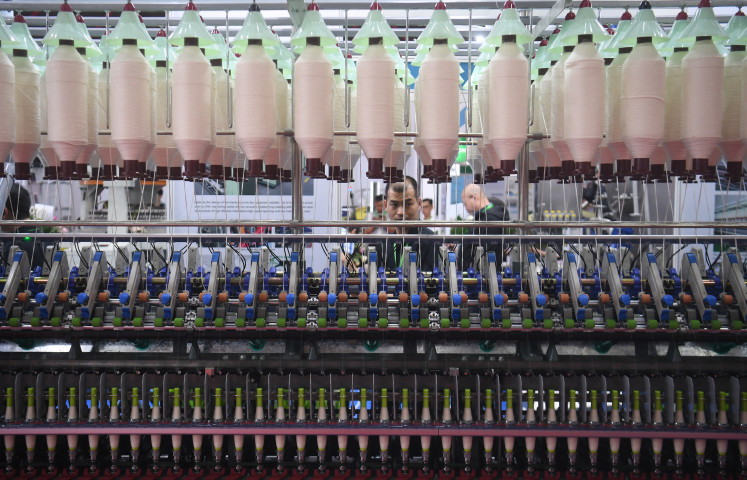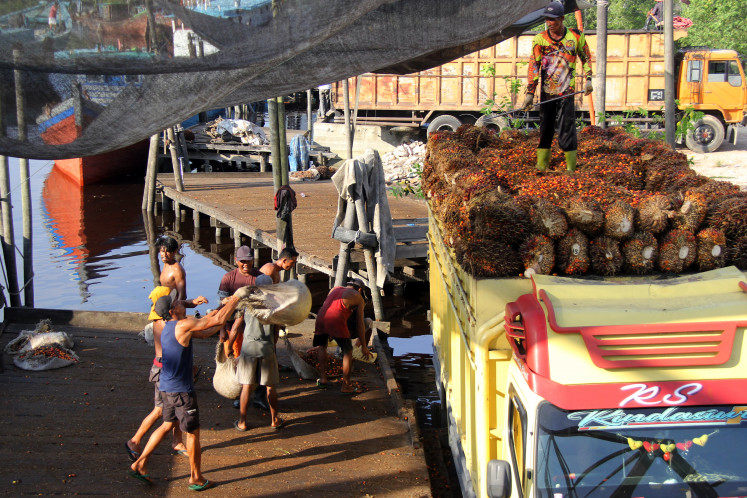Popular Reads
Top Results
Can't find what you're looking for?
View all search resultsPopular Reads
Top Results
Can't find what you're looking for?
View all search resultsMount Rinjani seeks savior
Falling heaven: Hikers enjoy a view of the Segara Anak crater during their descent from the peak of Mount Rinjani on Lombok Island, West Nusa Tenggara
Change text size
Gift Premium Articles
to Anyone
Falling heaven: Hikers enjoy a view of the Segara Anak crater during their descent from the peak of Mount Rinjani on Lombok Island, West Nusa Tenggara.
Indonesian mountaineers generally believe that you should make Mount Rinjani in West Nusa Tenggara the hight point in your exploration of the nation’s majestic peaks.
The “save the best for the last” principle applies while trekking Mount Rinjani o because the well-known panorama views are so breathtaking that visiting other peaks in this tropical country afterward may feel less fun because their views might feel too ordinary in comparison.
For instance, most climbers trek Mt. Merbabu in Central Java to get themselves immersed in its lush savanna meadow, while others visit Mt. Semeru in East Java to camp near its famous Ranu Kumbolo Lake, which has become a popular romantic gateway since its depiction in the film 5 cm.
However, what Mt. Rinjani has in its disposal simply dwarfs them all. From a fish-rich blue lake and beautiful green savanna, to hot water springs surrounded by waterfalls and green hills, the volcano is the all-round traveling destination of every backpacker’s dream.
Standing 3,726 meters above sea level, Mt. Rinjani is the second-highest volcano and the third-highest mountain in Indonesia, behind “Puncak Jaya” or Carstensz Pyramid in Papua and Mt. Kerinci in West Sumatra. Mt. Rinjani is still an active volcano, with activity recently recorded in 2004, 2010 and 2015.

Rocky waters: A view from Segara Anak Lake, located 2,000 meters above sea level. Surrounded by volcanic mountains, the crescent-shaped lake has always been one of the most appealing camping spots in the Mount Rinjani National Park.
The way to the top of Mt. Rinjani, believed to be the place where a dispelled princess named Anjani resides, is far from straightforward. It will take around eight hours of hiking from Sembalun village in the east of Lombok to reach Mt. Rinjani’s camp site, where climbers can rest and spend the night while enjoying the beautiful view of the crescent-shaped Segara Anak Lake from above.
After that comes the most challenging part of the hike: a four-hour steep climb on the windy and narrow trails to reach the summit, with sand and unstable rock footings.
The panorama during the summit challenge is amazing, with the small Barujari volcano (known as the “son of Rinjani” that deposits hot lava) blowing smoke on the right while edelweiss flowers are scattered on your left. However, full alertness is strongly advised as some parts of the trail are less than 5 meters in width and one small misstep can lead to disaster.
Nevertheless, the reward for those who overcome the mental and physical struggle to reach the summit is worth it. On a clear sunny day atop of Mt. Rinjani, one would be able to see the breathtaking landscape of Lombok Island and the three Gili Islands, with the elegant Mt. Agung firmly standing across just in Bali.
Despite all the majestic qualities of this mountain, locals and visiting tourists were sad to see the dark, dirty side of Mt. Rinjani. As I conversed with some of them, they all agreed that the national park had a serious environmental problem and was in dire need of a savior to tackle the issue.

Green trails: Local Lombok people head to a mineral water spring secluded in the middle of lush savanna meadows. Besides the gorgeous views from its peak, Mount Rinjani is also famous for its luxuriant green savanna that greets hikers during the early periods of their climb.
Their concerns are justified: among the nine mountains I have climbed in Indonesia, Mt. Rinjani is simply the dirtiest. Campsites there almost resemble landfills as non-organic trash from plastic bottles to snack sachets can be found easily scattered on the ground. The volcano’s trekking trails from Sembalun village are so filthy tourists even joke that an effective way to avoid getting lost is just to “follow the trash”.
Meanwhile, the hot springs of Mt. Rinjani and some parts of Segara Anak Lake have become seriously polluted as locals have ignored the ban of using chemicals such as shampoo or detergent for washing in the waters and dumping waste there. Due to the prevalence of trash, some of the waters in the lake have transformed in color, a miserable situation as locals say the lake used to be rich in biodiversity only a decade ago.
Sjoukje Mos, a 27-year-old traveler from the Netherlands, suggested that the West Nusa Tenggara administration learn from Nepal, which had built a comprehensive waste management system to manage the trash in its mountains and national parks.
“You really have a serious problem with the trash here,” she lamented.
— Photos by JP/Putera Satria Sambijantoro










